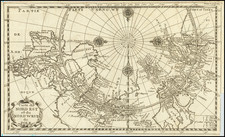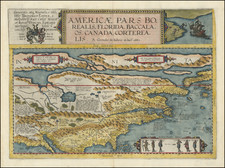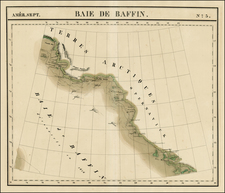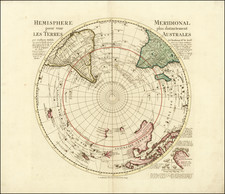Important early charting of Alaska and and the Northwest Coast of Canada, illustrating the most up to date discoveries along the coastlines and following the the discovery of the Northwest Passage.
First issued by the British Admiralty in 1853, this is without question one of the most important charts for tracking the discoveries and evolution of knowledge regarding Alaska. The present example includes significant revisions from the 1853 edition, most notably along the entire course of the Yukon River and its tributaries and neighboring topography, which has been added to and improved upon dramatically. The details along the Alaskan Range are also present in this edition of the map.
The chart is filled with details identifying the discoveries and surveys along the Alaskan Coastline, Behring Straits and tne Arctic Sea, along with some detail along the Yukon River, tracking the river to its various sources and showing Fort Yukon and other early primitive details in the Alaskan interior. The details around Kodiak Island and the whole of the Gulf of Alaska are changed dramatically, as are the contiguous rivers and coastal mountain ranges. An example of the University of Alaska's copy of the 1859 edition (as annotated in manuscript by George Davidson in 1867) can be seen here: vilda.alaska.edu/cdm/singleitem/collection/cdmg11/id/13492/rec/8
The map is one of three sheets published by the British Admiralty, showing the entire northwest passage. Examples of the other two charts can be seen here: /gallery/detail/30460.
The map is very rare, with only 1 example appearing in a dealer catalog in the past 30 years and no copies appearing at auction. OCLC locates no examples of this edition of the map. OCLC locates only 1 example of the 1853 edition (British Library) and 2 examples of the 1859 edition (University of Alaska and Connecticut State Library). OCLC locates no other examples prior to 1898. We also located examples at the Royal Geographical Society and Canadian National Archives (1853 edition). The University of Alaska copy is signed and annotated by George Davidson.
The British Admiralty has produced nautical charts since 1795 under the auspices of the United Kingdom Hydrographic Office (HO). Its main task was to provide the Royal Navy with navigational products and service, but since 1821 it has also sold charts to the public.
In 1795, King George III appointed Alexander Dalrymple, a pedantic geographer, to consolidate, catalogue, and improve the Royal Navy’s charts. He produced the first chart as the Hydrographer to the Admiralty in 1802. Dalrymple, known for his sticky personality, served until his death in 1808, when he was succeeded by Captain Thomas Hurd. The HO has been run by naval officers ever since.
Hurd professionalized the office and increased its efficiency. He was succeeded by the Arctic explorer Captain William Parry in 1823. By 1825, the HO was offering over seven hundred charts and views for sale. Under Parry, the HO also began to participate in exploratory expeditions. The first was a joint French-Spanish-British trip to the South Atlantic, a voyage organized in part by the Royal Society of London.
In 1829, Rear-Admiral Sir Francis Beaufort was appointed Hydrographer Royal. Under his management, the HO introduced the wind force scale named for him, as well as began issuing official tide tables (1833). It was under Beaufort that HMS Beagle completed several surveying missions, including its most famous voyage commanded by Captain FitzRoy with Charles Darwin onboard. When Beaufort retired in 1855, the HO had nearly two thousand charts in its catalog.
Later in the nineteenth century, the HO supported the Challenger expedition, which is credited with helping to found the discipline of oceanography. The HO participated in the International Meridian Conference which decided on the Greenwich Meridian as the Prime Meridian. Regulation and standardization of oceanic and navigational measures continued into the twentieth century, with the HO participating at the first International Hydrographic Organization meeting in 1921.
During World War II, the HO chart making facility moved to Taunton, the first purpose-built building it ever inhabited. In 1953, the first purpose-built survey ship went to sea, the HMS Vidal. Today, there is an entire class of survey vessels that make up the Royal Navy’s Hydrographic Squadron. The HO began to computerize their charts in the late 1960s and early 1970s. In 1968, the compilation staff also came to Taunton, and the HO continues to work from there today.











![[North Polar Calotte from a 17th Century Dutch Globe]](https://storage.googleapis.com/raremaps/img/small/70704.jpg)

![[An English Propaganda Map In French] Carte Des Possessions Angloises & Francoises Du Continent De L'Amerique Septentrionale 1755.](https://storage.googleapis.com/raremaps/img/small/86975.jpg)
